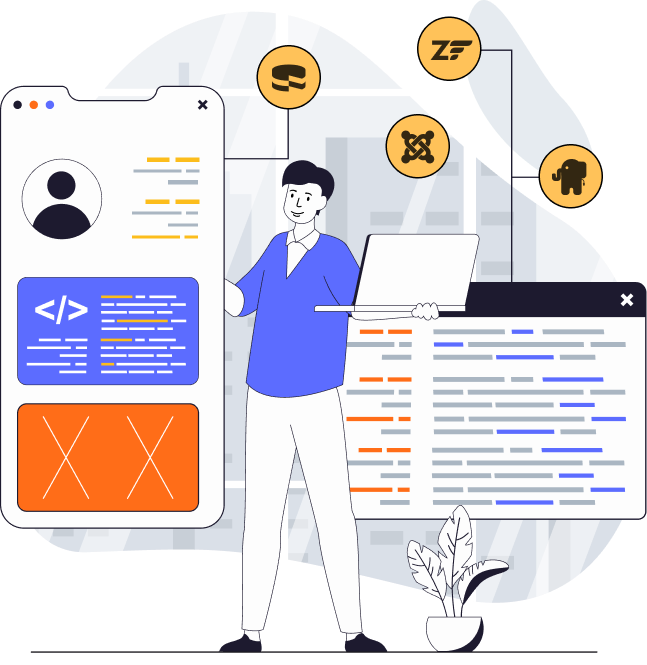List of Frameworks We Work With
IndaPoint is a premier provider of cutting-edge and high-performance frameworks, specializing in developing versatile interfaces for various industries.
Unlock the potential of your visionary project with our expert team. Contact us today and let's work together to bring your dream to life.
Embark on Your Visionary Project
Why choose Indapoint for Framework?
When you choose IndaPoint for framework services, you gain significant advantages for your software development projects.
Expertise
IndaPoint's team comprises of highly skilled and experienced developers proficient in a variety of frameworks.
Faster Development
Utilizing the skills of an IndaPoint can expedite the development process. Their proficiency with the framework enables them to work efficiently and produce timely results.
Focus on Core Business
By leveraging outsourced framework services, your internal team can prioritize key business functions like strategic planning and customer relations, while entrusting technical implementation to specialized experts. This strategic approach allows for optimized productivity and efficient utilization of resources.
Cost-Effective
When you enlist the services of a specialized IndaPoint company for framework services, you can benefit from cost savings compared to the expenses involved in recruiting and training an in-house team.
Access to the Latest Tools and Techniques
Stay ahead with IndaPoint as we constantly update our knowledge and expertise with the latest tools, technologies, and advancements within the framework.
Quality Assurance
At IndaPoint, we adhere to rigorous quality assurance protocols to guarantee that our final product adheres to the highest standards of quality.
Stay Digitally Competent With Framework Development Company
Attracting and retaining modern customers requires offering immersive experiences that embrace the latest trends. Today's consumers seek more than just the ordinary.
Customized portable solutions
Enhance database proficiency
Reinforces security
Accelerated Development
20+
Years Experience
50+
Talented Squad
1200+
Happy Clients
500+
Projects
Our Blogs: Feel the Beat of Innovation
Stay in sync with the latest in technology and business transformation.

Don’t Just Launch – Strategize: The 5 Battle-Tested Principles of Successful AI Agent Deployment
Launching an AI agent is just the beginning — true success lies in strategic deployment. This blog outlines five battle-tested principles to ensure your AI agents deliver real value: define clear objectives, build scalable infrastructure, maintain contextual awareness, monitor user feedback, and embrace continuous improvement. Whether it’s a customer-facing bot or an internal copilot, applying these principles helps avoid common pitfalls and maximizes your AI’s impact across user experiences and business goals. Don’t Just Launch – Strategize: The 5 Battle-Tested Principles of Successful AI Agent Deployment In the modern digital landscape, AI agents are becoming central to enhancing customer experience, boosting operational efficiency, and scaling intelligent automation. Whether you’re deploying an internal copilot to help employees or a customer-facing agent to streamline user queries, one truth remains: Deployment is not the destination — it’s the beginning of the journey. Yet, countless teams rush AI agents into production without a well-thought-out strategy. The result? Confused users, degraded performance, lost conversation threads, and a broken trust loop. To help you avoid these pitfalls, let’s explore five battle-tested principles for successfully deploying AI agents that don’t just function — they deliver real value. 1. The Principle of Clarity: Define with Precision One of the most common mistakes in AI deployment is launching agents with vague or overly broad objectives. If your AI agent is a “general-purpose helper” with no clear task scope, users will struggle to engage meaningfully — and the AI will struggle to perform. Key Actions: Identify the AI agent’s purpose:Is it meant to assist users in navigating a website, answering support tickets, or summarising meeting notes? Define specific goals and tasks:Break down high-level objectives into precise, actionable functions. Establish boundaries and limitations:What shouldn’t the agent do? Define areas outside its scope. Communicate explicit objectives to stakeholders:Ensure users and internal teams understand what to expect. DO: Clearly outline specific purposes, goals, and functionalities of your AI agent. DON’T: Deploy vague or overly generalised AI agents lacking clear objectives. Example: Instead of saying, “This is our AI support agent,” clarify with: “This AI assistant helps users reset passwords, track orders, and schedule deliveries — but does not handle billing or product returns.” 2. The Principle of Scalability: Build to Grow Launching an MVP (Minimum Viable Product) is essential, but assuming your MVP infrastructure can handle production-level demand is a recipe for failure. Scalability isn’t a “nice to have” — it’s foundational. As usage increases, your AI agent must withstand stress without degrading performance, accuracy, or response time. Key Actions: Run load and stress testing:Simulate heavy traffic and unpredictable user inputs. Evaluate performance metrics:Monitor latency, error rates, token usage, and more. Optimise infrastructure:Use scalable cloud architecture, caching mechanisms, and optimised pipelines. Deploy at scale cautiously:Roll out gradually with load balancers and autoscaling enabled. DO: Prepare and test AI agents to handle growing user interactions without performance loss. DON’T: Deploy without considering the impact of increased user demand. Example: If your AI agent works flawlessly with 100 users in staging, test how it behaves under 10,000 concurrent sessions — before going live. 3. The Principle of Contextual Awareness: Remember, Don’t Reset AI agents often falter when they lose context mid-conversation. Whether you’re building a chatbot or a task assistant, maintaining context continuity is critical for smooth, human-like interaction. Key Actions: Implement memory mechanisms:Use session or long-term storage to retain user data across interactions. Adopt Retrieval-Augmented Generation (RAG):Let your AI reference external knowledge bases to ground its responses. Update conversation context dynamically:Store and reference conversation history to make responses more relevant. Maintain continuity across sessions:Especially for returning users or complex workflows. DO: Equip AI agents with strong memory management and Retrieval-Augmented Generation (RAG) capabilities. Don’t Use AI agents that frequently lose track of user context and conversation threads. Example: Instead of starting from scratch with every input, let the AI say: “Earlier, you mentioned needing help with an invoice. Let me continue from where we left off.” 4. The Principle of Monitoring & Feedback: Listen and Learn One of the most significant errors in AI deployment is treating the launch as the finish line. But no AI agent is perfect at go-live. Real-world usage provides the richest source of insights — if you listen. Key Actions: Deploy real-time monitoring systems:Track usage, errors, drop-offs, latency, and intent recognition accuracy. Collect user feedback loops:Use thumbs-up/down ratings, comments, or follow-up surveys. Analyse interaction data continuously:What are users asking that the AI doesn’t understand? Identify performance gaps and missed intents:Find patterns in failure points to prioritise improvements. DO: Implement continuous monitoring and gather user feedback for ongoing performance evaluation. Don’t: Rely only on initial deployment metrics without regular checks and user insights. Example: Instead of assuming “the AI is working fine,” check dashboards for: Frequently misunderstood questions Unexpected user intents Repeated fallback responses 5. The Principle of Iterative Improvement: Evolve or Expire No AI agent should remain static. Like software products, AI agents thrive on iteration — driven by real-world usage, feedback, and newly available models or data. Key Actions: Monitor ongoing performance trends:Are user satisfaction scores improving or declining? Identify improvement opportunities:Which workflows are underperforming? Where is response relevance low? Plan updates and refinements regularly:Schedule sprints to retrain models, tweak prompts, or redesign flows. Implement changes with a versioning system:Log changes and track impact. Continuously re-evaluate and repeat the cycle:Make optimisation a permanent loop. DO: Regularly refine and update your AI agent based on real-world usage and data-driven insights. Don’t: Treat deployment as a final step; avoid neglecting improvements after launch. Example: After launch, your AI sees a surge in product-related questions. Use this insight to: Integrate your product database Add specific intents Fine-tune your prompts with product-related terminology. Conclusion In deploying AI agents, remember: success doesn’t come from simply launching—it comes from strategic, thoughtful execution. By embracing clarity, building for scale, maintaining context, listening actively, and committing to ongoing iteration, your AI agents can become more than functional—they can be impactful. Each principle ensures your deployment delivers real value while adapting to user needs and business goals. Ready to bring your AI agent strategy to life? At IndaPoint, we help you design, deploy, and scale intelligent AI solutions that truly perform. Whether you’re starting small or preparing for enterprise-level adoption, our team ensures your AI agents deliver clarity, context, and continuous improvement. Let’s turn your vision into a value-driven reality—connect with us today to future-proof your AI deployment!
April 09,2025

Generative AI: The Double-Edged Sword of Modern Technology
Generative AI is a rapidly evolving technology that creates new content by learning from existing data. It has transformed industries by automating content creation, enhancing personalization, and aiding innovation in fields like healthcare, gaming, and customer service. However, it also raises ethical and legal concerns, such as misinformation, bias, job displacement, and data privacy risks. As AI continues to advance, balancing its benefits and challenges is crucial.
April 03,2025

The Agentic AI Stack: Transforming Businesses with Intelligent AI Agents
The Agentic AI Stack is a powerful framework that helps businesses build intelligent AI systems that can think, learn, and collaborate like human teams. It consists of five essential layers—data retrieval, orchestration, reasoning, learning, and compliance—ensuring smooth automation, quick decision-making, and security. By using Agentic AI, companies can improve efficiency, enhance customer experiences, and drive innovation with a smart digital workforce.
March 31,2025
Frequently Asked Questions
-
How do you choose the right framework services provider for the project?
When choosing a framework services provider, it's crucial to assess their proficiency in the specific framework you need, their track record in handling similar projects, client feedback, industry standing, communication proficiency, and capability to fulfill your project needs and timeframes.
-
Can framework services providers handle full-stack development?
We have expertise in developing full-stack products using a variety of frameworks, encompassing both frontend and backend development.
-
Do framework services include ongoing support and maintenance?
We provide comprehensive post-development support and maintenance services to ensure that your application remains fully functional, secure, and updated beyond the initial development phase.









